Diane: My intention was to spend 1 day in Lima and get packing, but it looks like we'll be here a week. We located a neurologist the day we arrived. I find that neurologist is a hard word to say in Spanish, even though it looks very much like the English word and has fewer letters - neurólogo. If I take it slowly, one letter at a time, I can get to the end of the word without causing serious damage. TM has been living on ibuprofen for the last 2 weeks, due to back pain. The neurologist tendered good news - the problem is muscular only. On the downside, TM is taking muscle relaxants and must lay low for 3 weeks. TM does have permission to travel by bus after a week of bedrest.
Our friend, Micky, from Chiclayo contacted Marcial, a cousin in Lima, who is now making sure we find our way around Lima with no hassles. How lucky we are! Marcial is a taxi-driver in Lima. As it turns out, Lima is huge and spreads out in all directions. The center is surrounded by hundreds of thousands of people in squatter settlements made up of migrants from the rest of Peru. What better escort than a taxi-driver? Marcial helped us check out various accommodations, found a neurologist for us, took us there, drove us to our first tourist destination, and made sure we wanted for nothing.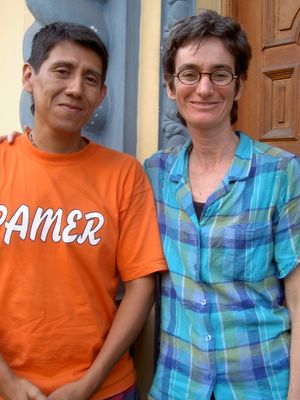
Central Lima contains a concentration of gorgeous colonial art and architecture. The Plaza Mayor is spectacular, with it's elaborate stonework and wooden balconies. In the colonial era, the sides of these balconies were made of wooden slats - behind which women could sit and view the activity on the square, without being seen.
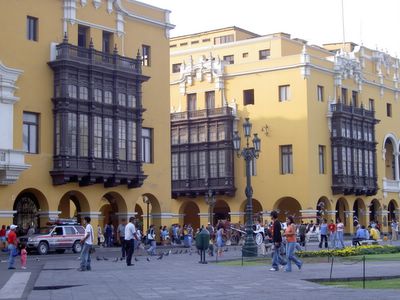
We saw the longest wooden balcony in Peru in Lambayeque. We saw the oldest wooden balcony in Peru in Trujillo. But those in Lima were extraordinarily ornate and well-maintained. Driving through the streets of Lima was a contrast in griminess and grand architecture. I caught this beautiful facade on a random corner as we drove through town.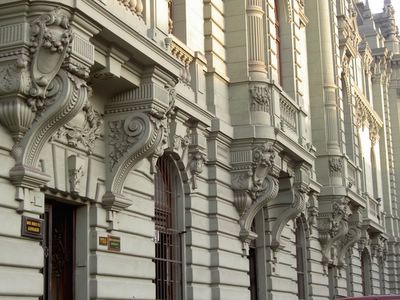
After spending some time with one of my guidebooks, Tom has decided on a breed to replace Milo-The-Wonder-Dog. They are called the Peruvian hairless. They have been around for at least 4000 years, but were only recently recognized as a distinct breed. Although I'm fairly sure it is the ugliest breed I have ever seen, I am giving it the benefit of the doubt and only asserting that it is the second ugliest breed I have ever seen. They are pretty much hairless, except for a few hairs on the top of their head. This makes them look like chemotherapy patients to me.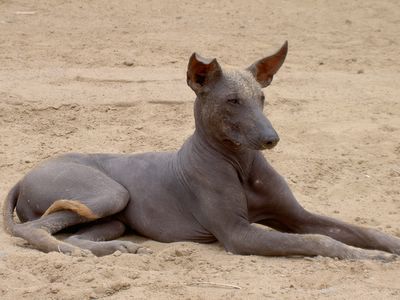
Many of them also have pink blotches on their skin, which reminds me of some kind of skin infection or maybe places where large scabs just peeled off. Update: Marcial located some 6-day old puppies that were totally cute.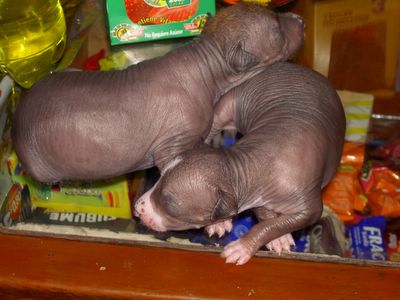
The Peruvian hairless has some remarkable qualities. They have a high body temperature. They can provide relief to those suffering from rheumatism after being tucked under the covers with them. They are also purported to cure asthma in children. One source says the Moche considered them guardians of the dead. The Inca nobility also kept them as pets. Marcial tells us that when winter comes to Lima, they need clothing to stay warm. If we jump through all the hoops and successfully take one home with us, maybe we'll have to turn down the air conditioning at night. With that thought in mind, I'm finding the breed looking more and more beautiful.
Lima also has some fabulous museums. Although they preserve and present the magnificent archaeological heritage of Peru, my mood was such that I was most taken with a series of illustrated diagrams in the National Archaeological Museum, describing the various racial mixtures as defined several centuries ago. There were actually laws passed concerning these racial divides. Unfortunately, I did not have my camera with me. Afterwads, I searched the internet for more info. Interestingly, different countries had different schemes. And, within Peru, the definitions varied slightly depending on the time period.
Note that we now say indigenous rather than Indian. Chino means Chinese - so somehow you get a Chinese when Blacks and Indians mix. The classifications below get even stranger. I don't remember seeing these at the museum, so perhaps they are from a different time period or location. Lobo means wolf. I would translate "Salta Atrás" as "Jump Back". "No te entiendo" means "I don't understand you". Wouldn't it be appropriate if, on the many forms we fill out that ask for race, someone put "I don't understand you". After reviewing all these definitions, one immediate observation is that the concept of race is pretty much an invention.
If the collateral damage of such a classification scheme weren't so horrid and unjust, it would be comical. Such definitions, if taken to their logical conclusion, would never end.
We are staying at the very-comfortable HomePeru. It is a bit of a sanctuary in the heart of Miraflores, an upscale Lima neighborhood. In addition to the large sitting rooms with comfy couches and ancient artifacts, we have a free wireless connection. In Lima, when I wake up at 2 in the morning and can't go back to sleep, I schlep downstairs with the laptop and get up-to-date on the latest medical research or technology advances. The hotel is located 2 short blocks from some ruins that aren't in any of my guidebooks - Huaca Pucllana. The bricks are turned on their sides, unlike any other huaca we've seen. And it's BIG. It is immediately surrounded on all sides by a residential neighborhood. I wonder what valuable artifacts the kids bring inside after playing in the backyard.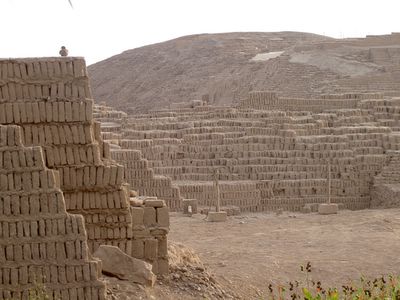
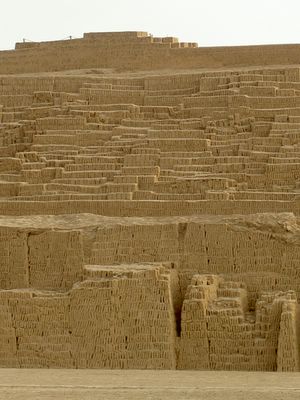

No comments:
Post a Comment